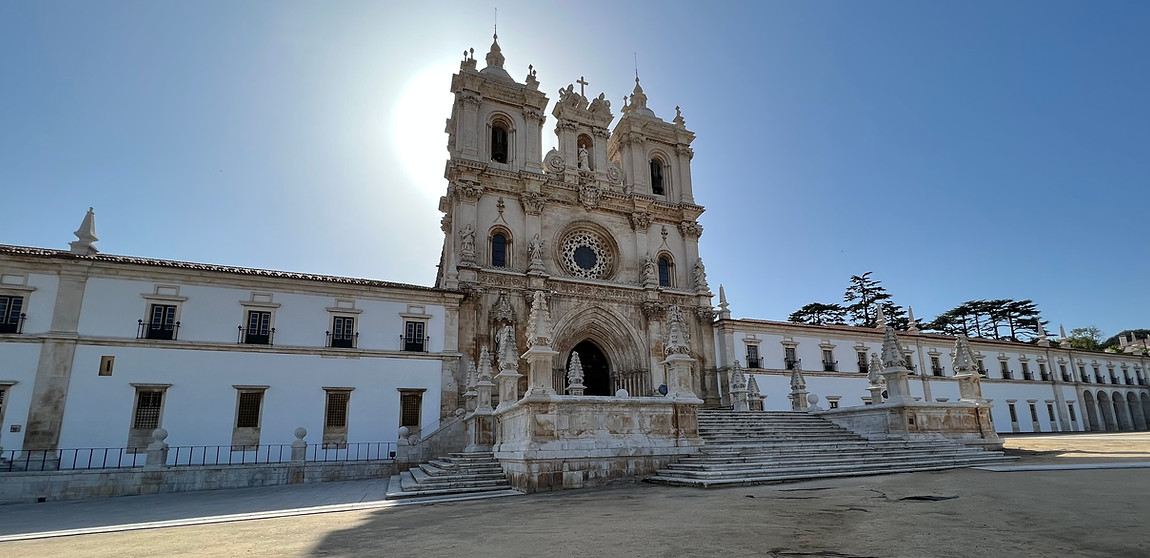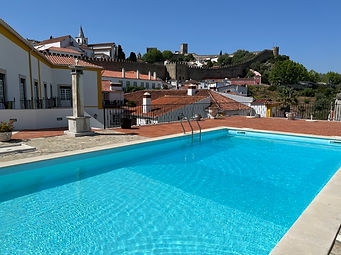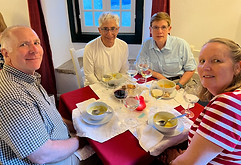
Alcobaça & Nazaré
Day 6: April 30
Alcobaça
We day-tripped from Óbidos today. It started with a ride to the town of Alcobaça, where we visited the Monastery of Santa Maria, established in 1183 by the first Portuguese king, Alfonso. It's been closely associated with the monarchy throughout its history. Is it one of the most important medieval monasteries in the country, the first Gothic building built in Portugal. Check out the awesome chimney in the center of the kitchen!









Claúdia's insightful tour helped us to envision the lives of the monks who lived here. There was even a bit of acting involved (showing us how they sat themselves at an angled desk to write manuscripts). In the photo at right, she is posed next to the "anti-gluttony" door. The story is that the monks had to pass through this door to get from the kitchen to the dining hall. Just 32 cm wide, this prevented them from eating too much. We knew from the twinkle in her eye that the story was just a bit of fun. The actual purpose of this door was to pass food outside to the poor, who were not allowed inside the monastery.

Portugal's history includes a tale of star-crossed lovers, its own Romeo and Juliet story. This famous 14th Century story of forbidden love was told to us on our tour when we got to the two elaborately carved tombs shown below. When Alfonso IV was king, his son and heir, Pedro, was in an arranged marriage to Constança, but Pedro was having a secret affair with her lady-in-waiting, Ines. After Constança died giving birth to Pedro's child, Pedro tried to make the relationship with Ines official, but his father forbid them to marry. In defiance, they lived together and had three children. Alfonso IV ordered Ines killed and the deed was carried out by three assassins who stabbed her to death and then decapitated her in front of her small child. When Pedro took the crown, he ordered the execution of Ines' murderers by publicly ripping their hearts out. He claimed that he and Ines had secretly married, and he posthumously crowned her. He had an elaborate tomb built for her and placed inside the monastery in Alcobaça, with the royal title Queen on it. Pedro decreed that after his own death, his tomb would be placed next to hers so they could be side by side for all of eternity.


Ines' tomb, pictured at left, is supported by six hybrid beings with human heads and animal bodies. Pedro's tomb, above, is on the backs of six lions. The tombs are no longer side by side but (as shown above) are displayed on opposite ends of the transept of the church.
We had a little free time in the town of Alcobaça after the monastery tour. We started with a coffee break because who could resist the exquisite pastries in the bakery right across the street! Then for a little slice of daily life, Gary and I went to the marketplace, where local residents buy their meat, cheese, produce, flowers and more while visiting with their neighbors.










Nazaré

I was ready to wriggle my toes in the sand now! I love beaches and was excited that our other day trip today was Nazaré, a town on the Atlantic Ocean coast with a very long, wide, crescent-shaped beach. Most of the town is at sea level, spreading out along this gorgeous bay, but at the north end of the beach there is a massive headland and on top of those dramatic cliffs is a separate part of town, the district known as Sitio. The two parts of town are connected by a funicular.
Our time in Nazaré was mostly going to be free time to relax or explore as we wished, but before turning us loose, Claúdia had a mission. She wanted us to experience eating percebes . . . boiled barnacles! Therefore, the bus dropped us off in the Sitio district, where local women peddle these little seafood snacks in the center of the square. The women dress in traditional clothing: colorful tops tucked into short skirts that are fluffed out by multiple petticoats, aprons tied around their waists, a pair of knee socks, the whole ensemble a colorful mishmash of patterns. Historically, the petticoats had a purpose. The fishermen's wives layered seven of them under their skirts to keep them warm as they waited for their husbands to return from the sea.
Looking at the bowl of barnacles, all I could think was, yikes, aren't these are the things that boat owners scrape from their boat hulls, sometimes finding it necessary to use chemicals and pressure washers? Who was the first person in history who thought it was a good idea to try to eat these? They are gnarly, with hard parts and rubbery parts, and I couldn't tell where the meat is and how to get at it. But Claúdia demonstrated. You pinch the shell, break the neck from the hard body, then twist, and the tube containing the meat can be pulled out. With your teeth, you scrape the meat out of the tube. Barnacles are as prized as shrimp or lobster in this part of Portugal. They're expensive because they're hand-harvested off of the rocks, which can be dangerous due to the crashing waves.
We all partook, although some more hesitantly than others. It was salty and pretty tender. I wasn't going to run right out and look for recipes incorporating barnacles, but I'm glad I had this unique cultural experience! Standing in Sitio's square, with a view of the sea, was the just-right place to munch on a barnacle!





Before our group split up for free time, Claúdia took us inside the church in Sitio's square. Igreja Nossa Senhora. She wanted to give us a quick peek. This Baroque church contains an important historic artifact, an ancient Black Madonna statue. The small wooden carving, which depicts Mary breastfeeding Baby Jesus, is believed to have been made in Nazareth and is said to be one of the oldest statues of Mary in the world. Its arrival here gave the town its name. The statue was hidden for 500 years during Muslim rule. Christians who re-discovered it in the 12th Century erected a church on the imposing cliff above Nazaré, a fitting place to house the precious statue.
A mural inside the church depicts one of the famed legends of the town. In the 12th Century, a knight hunting for deer was charging towards the cliffs in pursuit of his prey when suddenly a thick cloud of fog blanketed everything. He prayed for a miracle. The Virgin Mary appeared and his horse ground to a halt right before the cliff's edge, while the deer went over. The tale is so famous in Nazaré that the stag is depicted throughout town.



Some in our group walked down the path to the lighthouse and surf museum, but the beach in the lower part of town was calling my name, so instead Gary and I took the funicular down to the main part of Nazaré. We wanted to grab lunch in a beach-side café and then spend the rest of our time on and near the beach.
The views from the Sitio district are spectacular. There are several observation points as you walk along the cliffs and from these you can see the beaches on the north side of Nazaré's headland, world-famous surfing beaches. An underwater canyon here causes some of the most gigantic waves you'll find anywhere in the world. In the winter, they're generally 30 to 60 feet high, but waves as high as 100 feet have been measured. It's a paradise for daredevil surfers from around the globe.







To me, one of life's greatest pleasures is walking along a sandy beach, but in Europe I've learned to temper my expectations. The beaches I've visited have been rocky, sometimes made up of little round pebbles, sometimes bigger and sharper rocks, but almost never soft sand. But wow! The beach in Nazaré has amazingly silky sand! And look how empty it was the day we were there! If you don't want the sand between your toes, you can walk along the beach on the paved promenade. It has the fun wave-pattered mosaic tiles like we saw in Belém. Nazaré's beach checks all the boxes for me. The water is clear and a beautiful color. I like the drama of the rocky cliffs at the north end, and the whimsy of the display of colorful fishing boats. But what really makes this beach unique is the large area where fishermen and their wives dry and sell the day's catch.


















Tabernassa restaurant in Nazaré was a casual place where the two of us had a delicious lunch on the covered porch, enjoying a beach view.
Wrapping up the day back in Óbidos
Nazaré had been a relaxing good time, and back in Óbidos, we were still on vacation from our vacation. Gary got a chance to "rest his eyes." I took a stroll though the village. Some in our group walked on the ramparts. A few gathered around the pool. Others found a group of seats on the hotel's garden terrace, a perfect place to share some of that wine bought at the Rovisco Garcia estate. Life is good.
According to the tour's published itinerary, dinner was supposed to be on our own tonight, but we'd learned yesterday that Claúdia had arranged for a group dinner for us at a restaurant that was right across the street from our hotel. And then we'd need to gather in the hotel's lounge after dinner. This was the night for Buddy Intros!







I thought the water was freezing but it wasn't too cold for these show offs, er . . I mean . . brave souls. Introducing Mark, John, Ed and Greg, the Óbidos Not-So-Synchronized Dive Team.




Our hotel's terraces had great views of the castle wall. A few of us gathered to enjoy a happy hour prior to dinner. Each time Gary ordered a gin and tonic in Portugal, it was served in a large goblet with orange rather than lime as the garnish, but the only time it was also garnished with whole coffee beans was here in Óbidos. We were not in Kansas any more!
As if this bonus group dinner wasn't a big enough treat, Claúdia surprised us with a round of ginjinha after dessert, served in little chocolate cups.










Buddy Intros!

If your buddy failed to reveal any juicy tidbits, just make something up! It's all part of the fun! By waiting until the 6th day of our tour, Claúdia assured that Buddy Intros would be more lighthearted than serious. We'd already let our hair down with each other. Give everyone the straight scoop or embellish a little, your choice. Buddy Intros can be a hoot!





